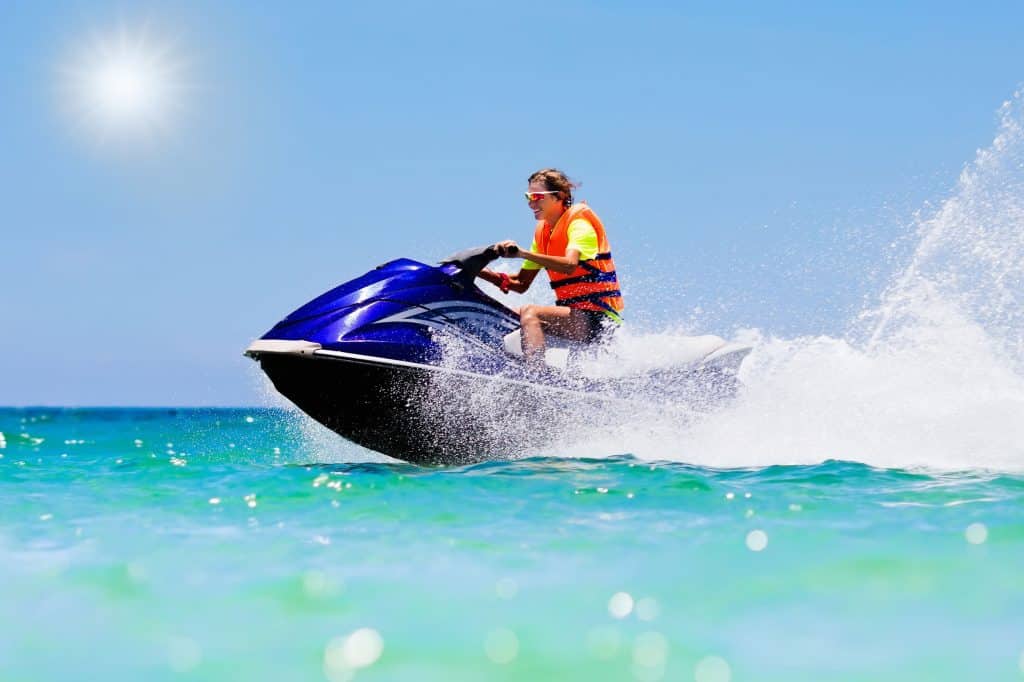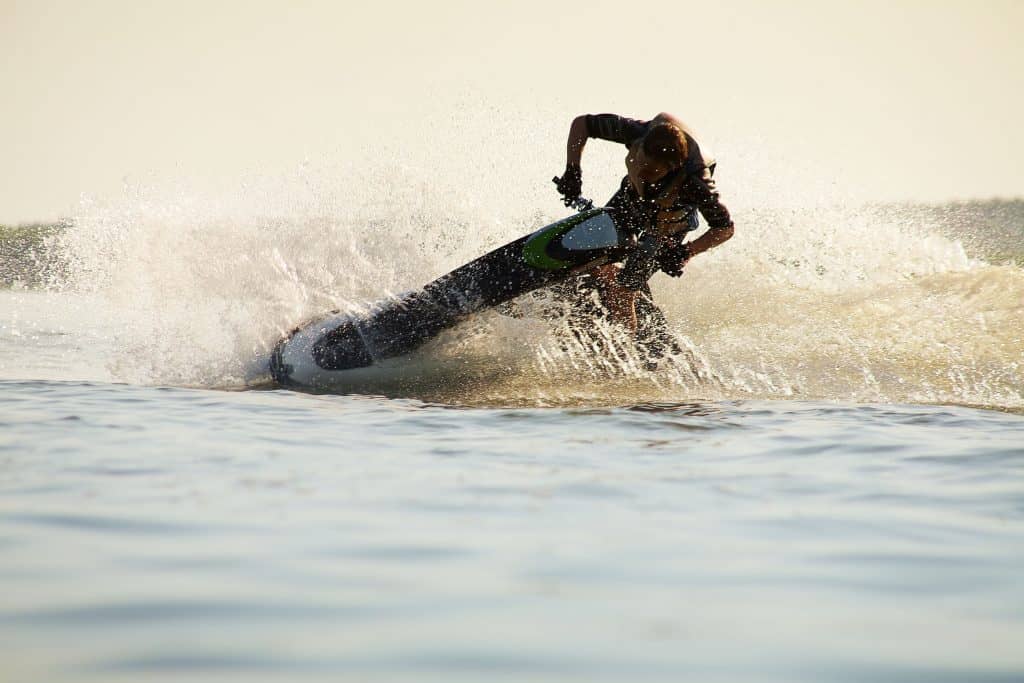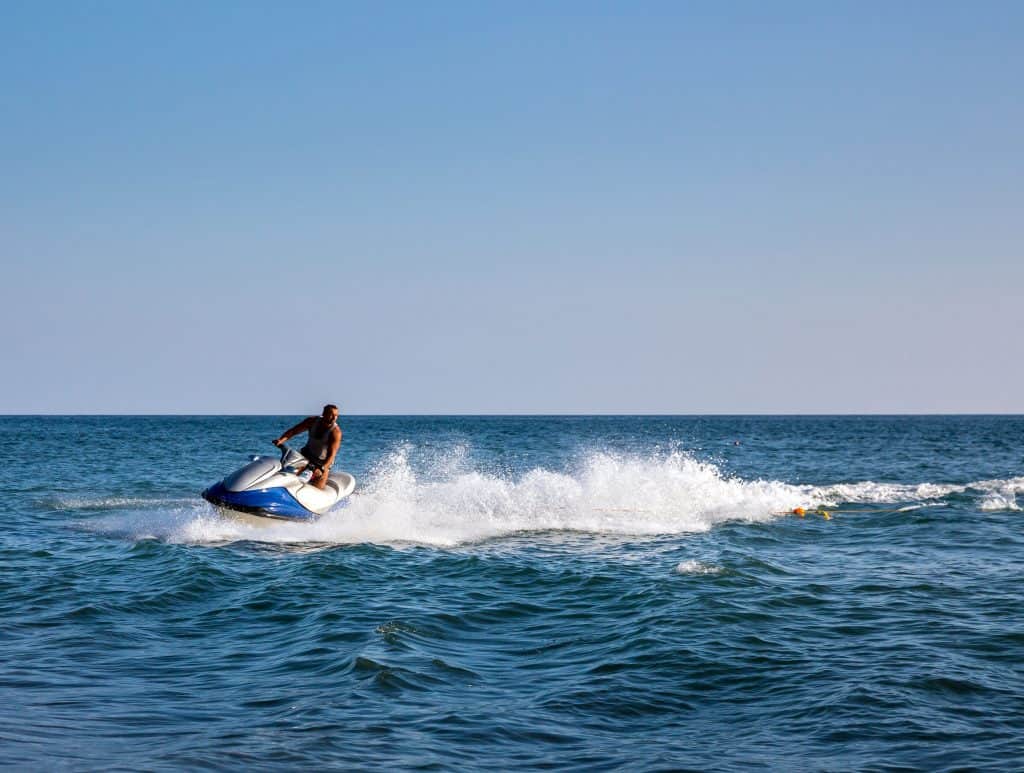Jet skiing in the summer is perfect for spending the day having fun. In order to ensure you don’t come across any trouble, you have to be sure that you know the regulations for jet skiing in the state of Idaho. Rules and regulations can vary from state to state and it is a need-to-know in order to be able to enjoy your time on the water.
Anyone 14 years of age or younger on a vessel that is 19 feet in length will need to wear an approved personal flotation device. Every person on a personal watercraft or anyone being towed on a PWC or vessel will need to wear a U.S. Coast Guard approved personal flotation device.
It is important to be aware of the following regulations and laws for riding a jet ski on the water within the state of Idaho. By doing so you are responsibly following the law and that will guarantee you have an adventurous and stress-free time on your jet ski with family and friends.

Registering Your PWC
In order to register your vessel in the state of Idaho you will need to obtain an Idaho Certificate of Registration and validation stickers in order to use your PWC or vessel legally on public waters.
You can obtain a certificate and validation stickers by submitting an application form and fee to the following: Idaho Department of Parks and Recreation Registration Section, Registration Section, P.O. Box 83720, Boise, ID 83720-0065.
Idaho Registration Fees
Boating registration fees within the state of Idaho follows a simple format to the total fee of registering your vessel. Vessels that are 12 feet and under are $20. Vessels over 12 feet are $20 and $2 every additional foot.
These prices stay the same year around and all boat registrations expire December 31. In addition to registering your vessel, you are required to pay an additional $10 for an Invasive Species Sticker.
Numbers and Stickers
Once you receive your registration number and the validation stickers you must display these items in the following ways:
- There cannot be any other numbers shown on the bow of your vessel
- The letters have to be separated from the numbers with space or hyphen
- Each number has to be painted, applied onto your vessel as a decal, or place to be shown on both sides of the bow
- The numbers must be read from left to right on both sides
- Each number must be in block letters and three inches high
- The color of your numbers must also be in contrast to the color of your vessel
Hull Identification Number
A Hull Identification Number (HIN) is a 12-digit number that is assigned by the manufacturer to vessels built after the year 1972. HIN helps be able to determine the differences between multiple vessels.
In case your vessel is stolen you should write down your HIN number and place it somewhere safe and secure.
The Idaho Invasive Species Fund
- Under this new law, you are required to purchase and display your IISF stickers in order to launch and operate your vessel in Idaho. This applied to any boat that is registered in Idaho, and any other non-motorized vehicle.
- Only vessels that are less than 10 feet in length are exempt from the requirement
- There is no additional fee to obtaining the sticker, when you complete any boater registration fee it is already paid

The Basics
PWC Rules and Regulations
Failure to Regulate Speed
When you operate your vessel at a faster speed than recommended you are putting those around you and yourself in danger. Especially during vessel traffic, poor weather conditions, and closeness to shore you will need to follow the speed regulation.
Examples of this are:
- operating your vessel at extreme speeds in the close vicinity of another vessel, PWCs, or dangerous waters
- operating at a greater speed than “slow, no wake speed” that is posted in a “no wake” zone
- going faster than the speed limit posted near the body of water you are operating on
- going at a speed that can be harmful to your vessel
Overloading or Overpowering
This is when you exceed the capacity your vessel or PWC can carry.
You should not exceed the max number of persons allowed or the max number of weight and combined weight of more than one person.
If you have a vessel that is powered by an outboard vessel you cannot exceed the allowed horsepower as well.
Negligent Operation
This is when you operate a PWC in such a way that it places you and others in the face of dangers. You also show no concern for the safety and property of others.
Examples of this are:
- boating in an area where buoys mark a swimming area or a restricted swimming area
- when you weave through congested traffic
- chasing, harassing or even disturbing wildlife with your PWC or vessel
- being airborne while crossing paths with another vessel at a very unsafe distance
- swerving at the last second to avoid collision with another vessel
Riding on the Bow, Deck, or Gunwale
Riding on anything that is not equipped with fixed seating can lead to the potential of falling overboard into the water.
Do not allow any of your passengers or even yourself to sit on the seat backs, transom, gunwale or on seats on raised decks or a bow.
Alcohol and Drugs
In the state of Idaho, a person will be considered to be under the influence of drugs and alcohol if:
- they are 21 years of age and their blood alcohol concentration is 0.08% or higher
- they are under 21 years of age their blood alcohol concentration is 0.02% or higher
The following penalties for boating under the influence are:
- receiving a maximum fine of $1,000 and a sentence of six months in the county jail
- you will be required to attend and complete a course on safe boating
- there will also be a loss of privileges to operate your PWC or vessel for up to two years
Anyone that is convicted of causing harm, permanent disability, or permanent disfigurement to any person other than himself or herself while operating a PWC or vessel while under the influence of drugs and alcohol will be guilty of a felony and will face:
- A sentence to the State Board of Corrections for up to 5 years with a minimum sentence of 30 days
- Receive a fine of up to $5,000
- Have their privileges to operate their vessel revoked for up to a year and cannot exceed two years after being released from prison

Required Equipment
Personal Flotation Devices
| Type 1 | Offshore Life Jackets | This vest can turn an unconscious person in the water to face up in the water. It was made for rough waters and for situations where rescue might take a long time. |
| Type 2 | Near-Shore Vests | This vest is fit for calmer waters and faster rescues. If you were to wear this while unconscious it may not be able to turn your face up in the water. |
| Type 3 | Flotation Aids | This vest can also be a full-sleeved jacket and it is great for calm waters and fast rescues. This will definitely not turn your face up in rough waters. This is generally worn for water sports. |
| Type 4 | Throw able Devices | This type of flotation device is a cushion or ring buoys and are typically used to throw at someone in trouble. They are not made to last for long hours in the waters, or non-swimmers, or the unconscious. |
| Type 5 | Special-Use Devices | This type of flotation device was made for activities like kayaking, water-skiing These typically look like white water vests, deck suits, and personal flotation device hybrids. |
Requirements for PFDs
- A type 4 PDF that is approved by the U.S. Coast Guard must be on board a vessel that is 16 feet or longer and it must also be easily accessible for emergency use
- vessels have to have 1 of the 5 personal flotation devices and they also must be wearable and a proper size so that anyone can wear it
- any person that is on board a PWC must wear a PFD that is approved by the U.S. Coast Guard.
Fire Extinguishers
You can classify your fire extinguishers by letter and number symbol. The number helps you decipher the size of the extinguishers, and the letter indicates the type of fire that is extinguished as well.
| TYPE A FIRES | These types of fires are combustible solids such as wood |
| TYPE B FIRES | These types of fires are flammable liquids like gasoline or oil |
| TYPE C FIRES | This type of fire is mainly electrical fires |
These fire extinguishers must stay in a usable condition. You need to regularly check up on the extinguishers to ensure they are in the best condition:
- seals and tamper indicators are not broken or missing
- pressure gauges or indicators read in the operable range
- there is no physical damage, corrosion, leakage, or clogged nozzles
